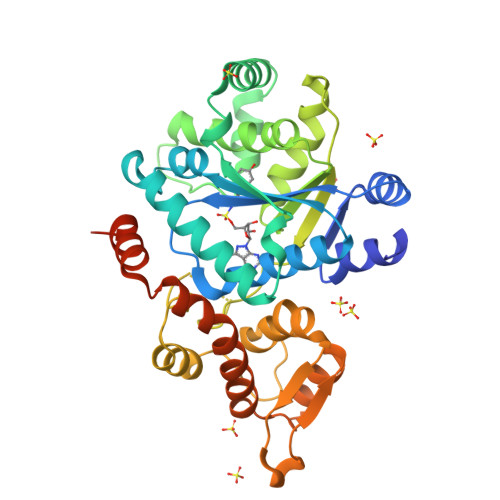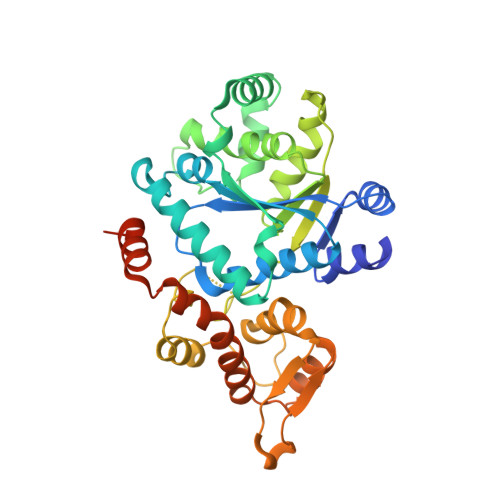Reaction hijacking of tyrosine tRNA synthetase as a new whole-of-life-cycle antimalarial strategy.
Xie, S.C., Metcalfe, R.D., Dunn, E., Morton, C.J., Huang, S.C., Puhalovich, T., Du, Y., Wittlin, S., Nie, S., Luth, M.R., Ma, L., Kim, M.S., Pasaje, C.F.A., Kumpornsin, K., Giannangelo, C., Houghton, F.J., Churchyard, A., Famodimu, M.T., Barry, D.C., Gillett, D.L., Dey, S., Kosasih, C.C., Newman, W., Niles, J.C., Lee, M.C.S., Baum, J., Ottilie, S., Winzeler, E.A., Creek, D.J., Williamson, N., Parker, M.W., Brand, S., Langston, S.P., Dick, L.R., Griffin, M.D.W., Gould, A.E., Tilley, L.(2022) Science 376: 1074-1079
- PubMed: 35653481
- DOI: https://doi.org/10.1126/science.abn0611
- Primary Citation of Related Structures:
7ROR, 7ROS, 7ROT, 7ROU - PubMed Abstract:
Aminoacyl transfer RNA (tRNA) synthetases (aaRSs) are attractive drug targets, and we present class I and II aaRSs as previously unrecognized targets for adenosine 5'-monophosphate-mimicking nucleoside sulfamates. The target enzyme catalyzes the formation of an inhibitory amino acid-sulfamate conjugate through a reaction-hijacking mechanism. We identified adenosine 5'-sulfamate as a broad-specificity compound that hijacks a range of aaRSs and ML901 as a specific reagent a specific reagent that hijacks a single aaRS in the malaria parasite Plasmodium falciparum , namely tyrosine RS ( Pf YRS). ML901 exerts whole-life-cycle-killing activity with low nanomolar potency and single-dose efficacy in a mouse model of malaria. X-ray crystallographic studies of plasmodium and human YRSs reveal differential flexibility of a loop over the catalytic site that underpins differential susceptibility to reaction hijacking by ML901.
Organizational Affiliation:
Department of Biochemistry and Pharmacology, Bio21 Molecular Science and Biotechnology Institute, The University of Melbourne, Melbourne, VIC 3010, Australia.




















